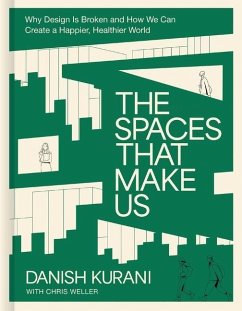Create a better life by creating better design. Did you know that. . . . . . the arrangement of your living room could improve your relationship with your partner? . . . the layout of your child's classroom affects their grades and test scores? . . . the design of your hospital room influences how quickly you recover? We live in a symbiotic relationship with the spaces around us--first we make our spaces, and then our spaces make us. But we're living in a suboptimal world, one that we designed. The good news: We can redesign it. For twenty years, architect and designer Danish Kurani has been transforming spaces to improve people's health and happiness through the design of schools, homes, offices, and community centers across four continents. The Spaces That Make Us offers you: * A clear, easy-to-follow philosophy you can apply to any space--your home, office, school, or neighborhood. * Surprising research revealing how design impacts your physical health, emotional well-being, and the quality of your relationships. * A journey through the past 2 million years, arriving at how current design practices make life worse. * An inspiring vision for creating future designs and a compelling call to rethink design's fundamentals * Practical strategies for using smarter design to improve your life, at any budget level. Kurani unveils a lifechanging design philosophy, Baaham (pronounced BAH-hum), a word from Urdu meaning "in tandem"--describing two interconnected things working in harmony. Baaham draws from psychology, sociology, anthropology, and evolutionary biology. Whether you're designing for yourself or others, at any scale from a bedroom to a city block, Baaham is a roadmap for improving health, building deeper relationships, and finding greater fulfillment. It's not just a philosophy--it's a way of life. Featuring seven core principles, Baaham helps everyone--from financially strapped college students to a manager looking to improve their team's performance--create environments that are functional, beautiful, and life-changing. This book doesn't tell you what to design. It teaches you how to design, so that you can build the life you want. Engaging illustrations are included throughout every chapter, to illuminate each principle and bring Baaham to life. The Spaces That Make Us will change how you see the world--opening your eyes to what isn't working, and helping you remake your spaces for a happier, healthier life.
Bitte wählen Sie Ihr Anliegen aus.
Rechnungen
Retourenschein anfordern
Bestellstatus
Storno








